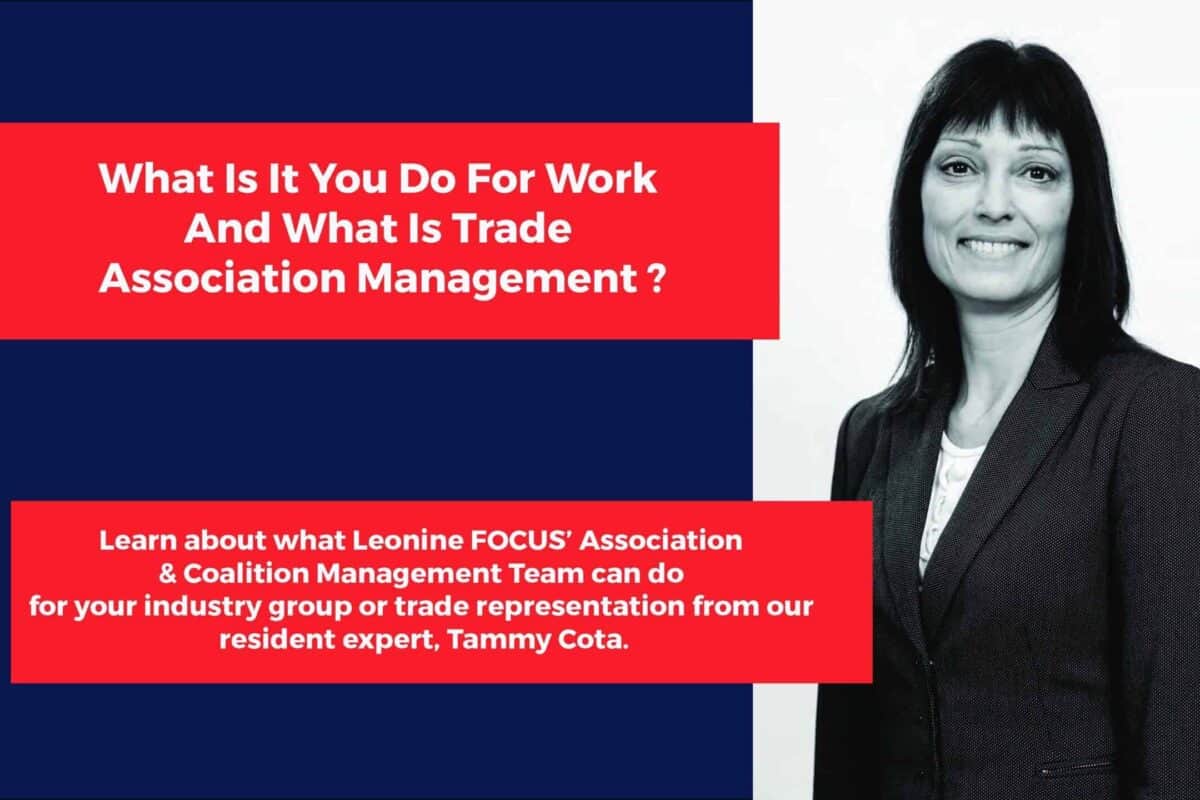By Tammy Cota – Director of Research for Leonine FOCUS and Executive Director of the Internet Coalition
I often find it difficult to explain to someone, usually a person I barely know, what I do for work. Responding with “I manage an internet trade association” often results in a blank stare or a repeat of the same question.
There really is no short answer. I have to begin by explaining that trade associations are a collection of like-minded companies that pool funds together to form an organization that operates in a certain way regarding issues of common interest. Whether the association is for-profit, non-profit or functions at the local, state or national level, they typically have the common goal of collaboration between member companies.
Trade groups vary widely by size, industry, scope and the services they offer. Currently there are over 7,600 national trade associations in the United States. Over 2,000 of those are located in Washington, D.C., but many others are spread across the country. The groups cover almost any industry you can think of, including an association of associations.
I then explain that services offered by associations include advocacy, public relations, meeting/event planning, charitable or political fund-raising, educational classes, courses and/or materials, policy development, leadership, campaign/political strategy or some combination thereof. Trades may operate at the local, state, federal and/or international level and could cover local ordinances, government contracting, or influencing state/federal/international legislation and/or regulations.
Many people have no idea what trade associations do. They are an effective advocacy tool, but new and seasoned business professionals may find it difficult to allocate the time and resources necessary to successfully create and maintain an association. It is a struggle providing timely and effective communications to members, keeping people engaged, and retaining and growing membership.
This is where I come in. FOCUS has provided association management services to clients since the early 90s. We partner with those looking to start new trade associations, to manage industry coalitions or to improve the effectiveness of their existing government affairs organizations.
Our association management work – which can include drafting and submitting testimony, handling accounting, hiring lobbyists and planning events – is often supplemented some of the other products FOCUS offers: bill and regulation information from our 50-state legislative and regulatory tracking services; on-the-ground intelligence from members of our TAG lobbyist referral network; restructuring based on our government affairs department audits; and intelligent content creation from our research and report-writing teams.
Through various positions I have held within the firm over the years, I found that most clients required some type of assistance in helping organize and effectively communicate with their members, and with policy makers. After all, everyone has experienced one of these two scenarios: You send out an email request and do not get a response or you invite people to events or meetings and they do not show up.
When I decide email is the best way to reach out, I craft it in a specific way to get a quicker response. For example, I often use “Important,” “Time Sensitive,” or “Please Respond,” in the subject line. Including a deadline for responding, that is highlighted in the body of the text, grabs people’s attention and I strive to be brief and to the point and more often than not include bullet points.
Member participation in industry conference calls or in meetings should be a priority for maintaining an effective coalition. Attendance can be increased simply by communicating to members shortly before a scheduled event to encourage participation, offering assistance and an explanation of what is expected from them.
One of the most challenging tasks of association management could be increasing membership. It is exactly like selling a commodity or service. Researching and obtaining good membership prospects are vital, as well as development of an effective and tailored sales pitch pointing out real world examples of how membership could specifically help that organization. I often enlist existing members to offer referrals, provide introductions or approach potential members directly.
Most importantly, I have formed real relationships with many of my members over the years, which I actually enjoy and coincidentally find it has resulted in longer member retention. If possible, I meet face–to-face with each member at least twice a year. I know from personal experience it is more enjoyable to collaborate with someone I know. And likewise, if that person happens to be providing me with valuable and reliable services which help me do my job better, I actually look forward to interacting with them and will hesitate before ending those benefits.
What exactly it is I do for work does take some time to explain. However, what is the alternative to this long explanation? Maybe instead I should say “I do research” as that typically solicits a head nod and then a quick change of subject.


